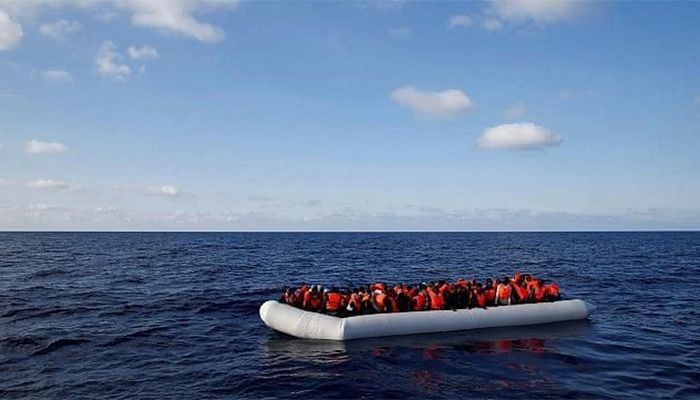
Desk Report
Publish: 19 Jun 2021, 07:05 pm

The riskiest route for human trafficking is the Mediterranean.|| Photo: Collected
In the last month, 529 Bangladeshis who had migrated to
different countries of Europe via the Mediterranean have been rescued. Of
these, 443 were rescued from Tunisia and 76 from Libya.
Concerned Authorities said that the Tunisian Coast Guard
rescued 36 people from crossing the Mediterranean to Italy on May 18, 243 on
May 27 and 28 and 164 on June 10. Last month, Libyan anti-immigration (DCIM) officials
rescued 86 Bangladeshis from their captors in the Algerian border town of Darras.
They were captured by kidnappers on their way to the Mediterranean via
Benghazi.
According to the International Organization for Migration
(IOM), 813 migrants died in the Mediterranean between January 1 and June 12
this year. With the help of this organization, 160 Bangladeshis returned to the
country last May. Moreover, 2,900 Bangladeshis rescued from the Mediterranean since
2015 have returned to the country from Libya with the help of IOM.
The Mediterranean is the riskiest route for human
trafficking in various European countries. The rescue of citizens of various
countries from the Mediterranean on the coast of Tunisia is constantly
happening. While going here, many drowned in the sea, some were caught by the
police and tortured, while others fell into the clutches of the kidnappers.
Even then, the tendency of Bangladeshis to reach Europe by crossing this dangerous
path is not stopping.
The Tunisian Coast Guard rescued 36 Bangladeshis, including
Alamin, from a wooden boat floating in the Mediterranean on May 18. He saw his
uncle sink in the sea on a dangerous journey to Italy via Libya. He himself
somehow survived death. Yet he does not want to return to the country.
Al-Amin said, ‘I have borrowed a lot to go to Italy. But I
could not go. If I can't go, how can I repay the loan? '
Sohail Rana, who has been in Libya for more than two years
hoping to go to Italy, said he boarded a boat to go to Italy on a contract
worth Tk 200,000 and now is working in Tunisia. But he does not want to return
to Bangladesh.
Using a Mediterranean route is not the only human trafficking
route. According to the Bangladesh Police and the United Nations, human
trafficking from Bangladesh takes place every year in India, Pakistan, Syria,
Lebanon, Jordan, Saudi Arabia, Kuwait, Oman, Bahrain, Thailand, Malaysia, and
other countries of the world. Most of them are women and children.
Police have tracked down an international woman trafficking
ring after a video of a Bangladeshi girl being tortured went viral on social
media in India recently. In 2015, 139 mass graves, including 28 abandoned
concentration camps, were found in a mountainous forest bordering Thailand in
northern Malaysia. Later mass graves were also found in Malaysia. A torture camp
was also found. The bodies of hundreds of Bangladeshi nationals smuggled by sea
as well as Rohingya nationals of Myanmar have also been buried in the mass
graves.
That year, the government repatriated 175 victims of human
trafficking from those two countries and Indonesia. They filed three cases with
the airport police. The trafficking ring has been convicted in a trial in
Thailand. Justice is still pending in Bangladesh. Only six were arrested in
that matter.
Although there is a case in these cases, the investigation
does not proceed. A high-ranking police source said that since the enactment of
the Prevention and Suppression of Human Trafficking Act in 2012, 9,692 people
have been arrested in about 6,000 cases till last December. And since 2014,
only 54 people have been convicted. The rate of case settlement is very low.
Many of those involved say that in human trafficking cases,
arrests are made primarily by early-stage dealers, usually those who are known
or neighbors of the victim. Many accused were acquitted due to a lack of
investigation.
Another major problem in such cases is the failure of the
police to produce witnesses in court. Dhaka Metropolitan Public Prosecutor
Abdullah Abu said there were no regular witnesses in the cases of human
trafficking.
The Criminal Investigation Department (CID) of the police
works to prevent human trafficking. CID Additional Inspector General (DIG)
Imtiaz Ahmed said the main part of the human trafficking ring is outside of the
country. Some brokers work locally. In many cases, victims do not provide
information.
Shahdin Malik, a senior Supreme Court lawyer, said it was
difficult to prove such cases without the help of victims. Moreover, if the
punishment is increased, the burden of proof becomes heavier. If we want to
increase the example of punishment, the law will have to be reformed.
Tasnim Siddiqui, chairperson of the Refugee and Migratory
Movements Research Unit (RMMRU), a private research firm on immigration, said
traffickers share money with many. It will take the political will of the
government to stop it.
Human trafficking is one of the biggest problems in the
country. But analysts say the government is not paying enough attention to the
issue. Although some small portions were caught in the raid, the main culprits remained
out of reach. Human trafficking cannot be stopped due to lax law enforcement.
Every year a significant number of people migrate to various countries of the world in search of better life or employment. Human traffickers are trapping them into the lure of lucrative jobs and opportunities. Awareness needs to be raised among the general public to protect against fraud, say those concerned. In addition, steps must be taken to repatriate the rescued Bangladeshi citizens from Tunisia and Libya quickly and safely.
Subscribe Shampratik Deshkal Youtube Channel
Topic : Human Trafficking Bangladesh
© 2024 Shampratik Deshkal All Rights Reserved. Design & Developed By Root Soft Bangladesh